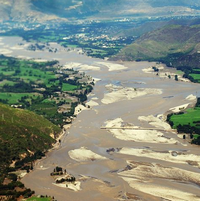This is Part III in a four-part series. Part I examined the follow-up agreement to the Kyoto Protocol. Part II examined the REDD+ agreement. Part III examines financial assistance. And Part IV will examine technology transfers and adaptation.
CANCÚN, Mexico -- The great paradox confronting international climate change talks like December's Cancún conference is simple: The countries who have contributed least to global emissions of greenhouse gases will bear the greatest brunt of the changing weather patterns that result from them. Conference participants and observers agree that the solution is also simple: Those who have polluted the most should fix the problem. Reaching agreement over the practical steps needed to do so, not surprisingly, presents greater complexities, and great costs.
The Kyoto Protocol dealt with this central problem, but only to a certain extent. It mandated that the 37 developed countries who signed the accord take steps to reduce emissions to well below their 1990 levels. It does not currently require changes in the developing world.

